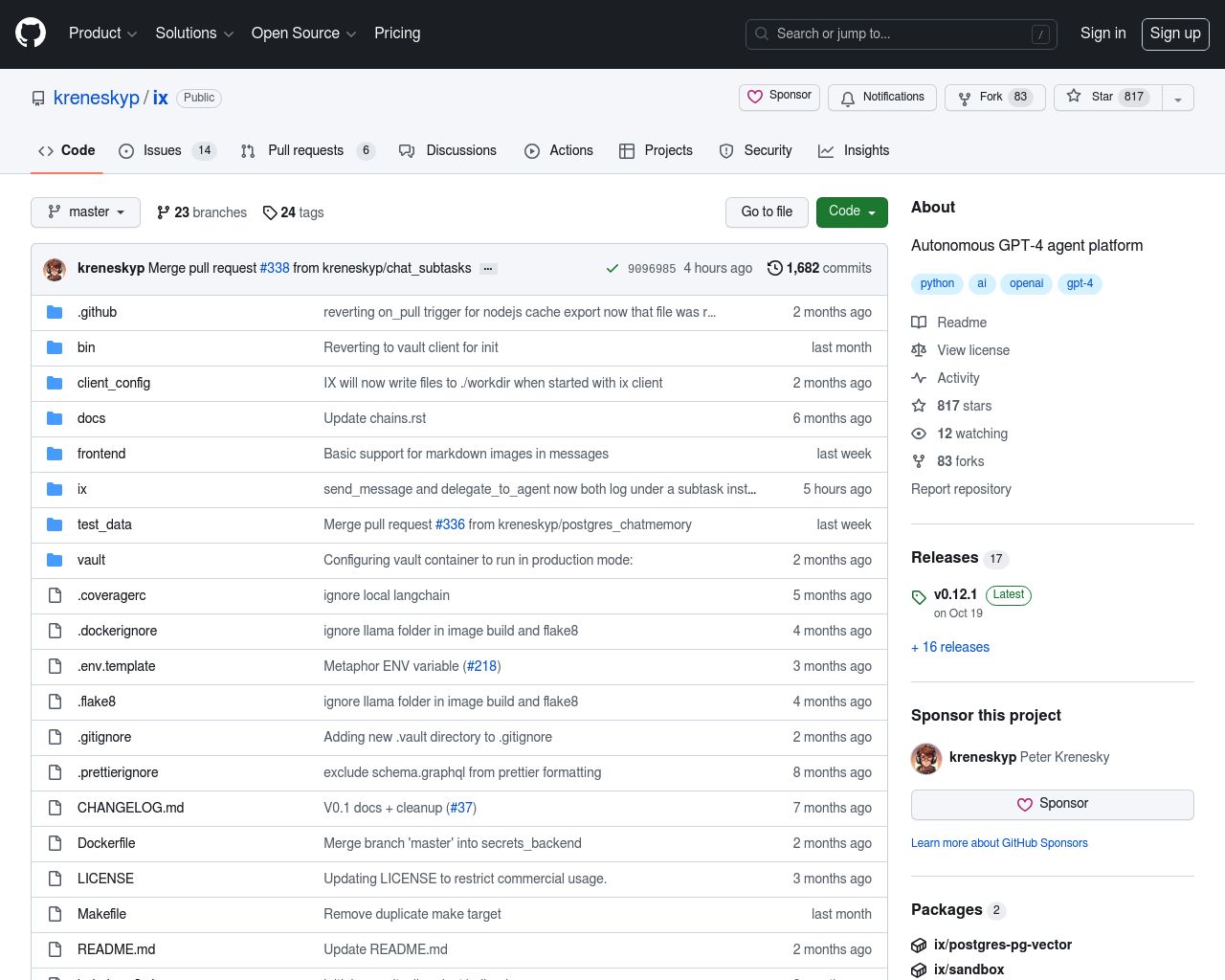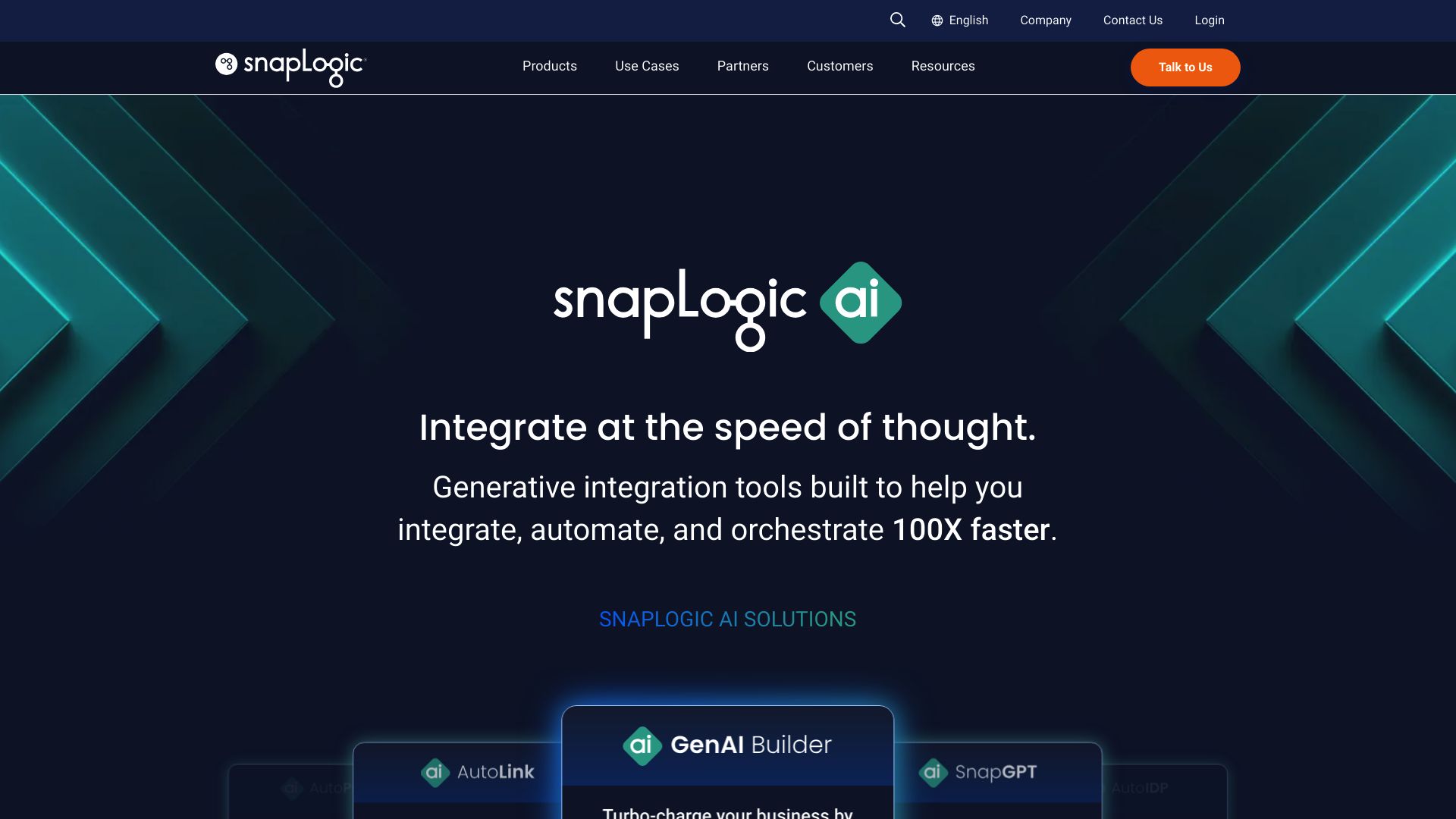Agent iX vs. snapLogic AI: Comparing AI-Powered Automation Platforms
AI-powered platforms revolutionize how businesses automate tasks, integrate systems, and leverage data. This review compares Agent iX vs. snapLogic AI, and SmythOS, three leading solutions in the AI automation space. We examine their key features, strengths, and limitations to help you choose the best platform for your needs.
Whether you’re a developer seeking powerful API integrations, a business leader focused on scalability and security, or a non-technical user looking for intuitive no-code tools, our analysis covers the critical aspects that matter most to diverse user groups. Discover how these platforms stack up in creating AI agents, handling complex workflows, and delivering enterprise-grade integration capabilities.
Agent iX Overview
Agent iX empowers developers to create, host, and manage AI agents through an open-source platform. The system excels in running multiple agents simultaneously, fostering collaboration and knowledge sharing among autonomous entities.


Agent iX’s no-code editor stands out as a key feature, providing an intuitive graphical interface for building AI agents. Users can construct agent logic through drag-and-drop interactions, making the platform accessible to those with minimal coding experience. This visual approach enhances transparency and explainability in agent operations.
Agent iX’s no-code editor stands out as a key feature, providing an intuitive graphical interface for building AI agents.
The platform supports a wide range of capabilities, including web research, task automation, code generation, and API integration. Agent iX utilizes foundation AI models like OpenAI, Google PaLM, and Anthropic, enabling diverse use cases across industries. The system’s dockerized setup ensures scalability and efficient resource management for both development and production environments.
While Agent iX offers robust features for agent creation and collaboration, it lacks some advanced capabilities. The platform does not explicitly mention support for multimodal inputs, data encryption, or hosted vector databases. Additionally, features like YouTube transcript crawling and PDF support are not specified in the available documentation.
snapLogic AI Overview
SnapLogic AI revolutionizes enterprise integration with its Intelligent Integration Platform (IIP). This AI-powered solution automates the entire lifecycle of IT integration projects across on-premises, cloud, and hybrid environments. SnapLogic’s platform caters to both expert integrators and citizen developers, offering a user-friendly interface for managing complex application and data integration tasks.
snapLogic AI leverages advanced AI capabilities, including their proprietary Iris AI technology, to streamline integration processes. The platform’s AI-driven approach significantly reduces the time and effort required for IT projects, providing intelligent recommendations for building data pipelines with high accuracy. This AI-centric design enables users to create sophisticated integrations without extensive coding knowledge.
SnapLogic AI revolutionizes enterprise integration… This AI-powered solution automates the entire lifecycle of IT integration projects across on-premises, cloud, and hybrid environments.


The platform’s core strength lies in its comprehensive integration support. SnapLogic handles a wide array of data types and sources, including structured and unstructured data, as well as batch, real-time, and streaming data. The system utilizes “Snaps” — pre-built integration connectors that simplify the process of linking SaaS and on-premises applications with various data sources.
SnapLogic handles a wide array of data types and sources, including structured and unstructured data, as well as batch, real-time, and streaming data.
SnapLogic AI’s scalability sets it apart in the competitive landscape. By leveraging Amazon’s Elastic Compute Cloud (EC2) infrastructure, the platform scales integration processes dynamically according to enterprise needs. This elastic integration capability optimizes computing power consumption and data proximity, allowing businesses to adjust resources based on demand.
Recent advancements in SnapLogic’s offerings include the introduction of SnapGPT and GenAI Builder. These tools enable no-code development of AI applications, allowing employees to create AI models and chatbots using natural language prompts. This democratization of AI development aligns with the growing trend of making advanced technologies accessible to a broader range of users within organizations.
While SnapLogic AI offers powerful capabilities, users should consider potential challenges such as the learning curve associated with its extensive feature set and the need for careful management of integration workflows to optimize performance. Additionally, as with any cloud-based solution, organizations must ensure proper data governance and security measures are in place when implementing SnapLogic AI in their IT ecosystems.
Feature Comparison
Agent iX and snapLogic AI offer distinct approaches to AI-powered integration and automation. Agent iX focuses on creating autonomous AI agents for task execution, while snapLogic AI specializes in enterprise-grade data and application integration. Agent iX provides a visual no-code editor for building AI agent workflows, enabling users to design complex cognitive logic without coding. In contrast, snapLogic AI leverages its Iris AI technology to automate integration processes across cloud and on-premises environments.
A key feature gap exists in multimodal capabilities. Agent iX lacks explicit support for handling diverse input types simultaneously, whereas snapLogic AI’s platform processes various data formats, including structured, unstructured, batch, and real-time data. Additionally, snapLogic AI’s emphasis on enterprise-grade security and scalability outpaces Agent iX in these areas. SnapLogic’s platform offers robust data encryption and leverages Amazon EC2 for dynamic scaling, features not prominently highlighted in Agent iX’s documentation.
Agent iX excels in its focus on autonomous agent collaboration, allowing multiple AI agents to work together on complex tasks. SnapLogic AI, while strong in integration capabilities, does not emphasize multi-agent systems to the same degree. However, snapLogic’s recent introduction of SnapGPT and GenAI Builder for no-code AI application development narrows this gap, offering capabilities that compete with Agent iX’s AI agent creation features.
| Agent iX | snapLogic AI | SmythOS | |
|---|---|---|---|
| CORE FEATURES | |||
| Hosted Agents (Dev, Production) | ❌ | ✅ | ✅ |
| Environments (Dev, Production) | ❌ | ✅ | ✅ |
| Memory & Context | ❌ | ❌ | ✅ |
| Autonomous Agents | ❌ | ✅ | ✅ |
| Explainability & Transparency | ❌ | ✅ | ✅ |
| Debug Tools | ❌ | ✅ | ✅ |
| Multimodal | ❌ | ✅ | ✅ |
| Audit Logs for Analytics | ❌ | ✅ | ✅ |
| Work as Team | ❌ | ✅ | ✅ |
| SECURITY | |||
| Data Encryption | ❌ | ✅ | ✅ |
| OAuth | ❌ | ✅ | ✅ |
| IP Control | ❌ | ✅ | ✅ |
| COMPONENTS | |||
| Foundation AIs | ✅ | ❌ | ✅ |
| Huggingface AIs | ❌ | ❌ | ✅ |
| Zapier APIs | ❌ | ❌ | ✅ |
| Classifiers | ❌ | ❌ | ✅ |
| Data Lakes | ❌ | ✅ | ✅ |
| DEPLOYMENT OPTIONS (EMBODIMENTS) | |||
| Deploy as API | ❌ | ✅ | ✅ |
| Deploy as Webhook | ❌ | ✅ | ✅ |
| Staging Domains | ❌ | ❌ | ✅ |
| Production Domains | ❌ | ❌ | ✅ |
| API Authentication (OAuth + Key) | ❌ | ✅ | ✅ |
| Deploy as Site Chat | ❌ | ❌ | ✅ |
| Deploy as Scheduled Agent | ❌ | ✅ | ✅ |
| Deploy as GPT | ❌ | ❌ | ✅ |
| DATA LAKE SUPPORT | |||
| Hosted Vector Database | ❌ | ❌ | ✅ |
| Sitemap Crawler | ❌ | ❌ | ✅ |
| YouTube Transcript Crawler | ❌ | ❌ | ✅ |
| URL Crawler | ❌ | ❌ | ✅ |
| PDF Support | ❌ | ✅ | ✅ |
| Word File Support | ❌ | ✅ | ✅ |
| TXT File Support | ❌ | ✅ | ✅ |
Best Alternative to Agent iX and snapLogic AI
SmythOS stands out as the superior alternative to Agent iX and snapLogic AI, offering a comprehensive platform for AI agent development and deployment. Our drag-and-drop interface simplifies the creation of complex AI workflows, making advanced AI functionalities accessible to users of all skill levels. We provide extensive integration options, supporting various AI models, APIs, and tools, ensuring seamless incorporation into existing systems.
SmythOS stands out as the superior alternative to Agent iX and snapLogic AI, offering a comprehensive platform for AI agent development and deployment.
Unlike Agent iX and snapLogic AI, SmythOS excels in multimodal capabilities, processing diverse input types simultaneously. We offer robust security features, including data encryption and OAuth support, addressing enterprise-grade requirements. Our platform enables true multi-agent collaboration, allowing AI agents to work together on complex tasks — a feature not prominently available in Agent iX or snapLogic AI.
SmythOS excels in multimodal capabilities… Our platform enables true multi-agent collaboration, allowing AI agents to work together on complex tasks
SmythOS provides unparalleled flexibility in deployment options. Users can deploy AI agents as APIs, webhooks, scheduled tasks, or even integrate them into popular platforms like ChatGPT. This versatility, combined with our scalable architecture, ensures that SmythOS meets the evolving needs of businesses across industries.
With SmythOS, we’ve eliminated the limitations found in Agent iX and snapLogic AI. Our platform offers a complete ecosystem for AI development, from ideation to deployment, without compromising on ease of use or advanced capabilities. By choosing SmythOS, users gain access to cutting-edge AI technology that drives innovation and efficiency across their organization.
Conclusion
Agent iX, snapLogic AI, and SmythOS each offer unique approaches to AI-powered automation and integration. Agent iX excels in creating autonomous AI agents with its visual no-code editor, while snapLogic AI focuses on enterprise-grade data integration with powerful AI capabilities. However, SmythOS emerges as the superior choice, combining the strengths of both platforms and addressing their limitations.
SmythOS stands out with its comprehensive feature set, including multimodal capabilities, advanced security measures, and scalable deployment options. Unlike Agent iX, SmythOS offers robust support for diverse input types and enterprise-grade security. It surpasses snapLogic AI in its focus on autonomous agent collaboration and provides a more intuitive drag-and-drop interface for creating complex AI workflows.
The platform’s versatility is unmatched, supporting over 300,000 integrations and allowing users to deploy AI agents across various platforms effortlessly. This ’Create Once, Deploy Anywhere’ approach sets SmythOS apart, making it an ideal solution for businesses seeking to leverage AI across multiple channels and services.
To experience the power of SmythOS firsthand, we invite you to explore our diverse range of AI-powered agent templates. These templates cover multiple business categories and offer a quick start to streamline your processes. For those ready to dive in, you can create a free SmythOS account and start building AI agents with no time limit. Discover how SmythOS can revolutionize your approach to AI automation and integration today.
Last updated:
Disclaimer: The information presented in this article is for general informational purposes only and is provided as is. While we strive to keep the content up-to-date and accurate, we make no representations or warranties of any kind, express or implied, about the completeness, accuracy, reliability, suitability, or availability of the information contained in this article.
Any reliance you place on such information is strictly at your own risk. We reserve the right to make additions, deletions, or modifications to the contents of this article at any time without prior notice.
In no event will we be liable for any loss or damage including without limitation, indirect or consequential loss or damage, or any loss or damage whatsoever arising from loss of data, profits, or any other loss not specified herein arising out of, or in connection with, the use of this article.
Despite our best efforts, this article may contain oversights, errors, or omissions. If you notice any inaccuracies or have concerns about the content, please report them through our content feedback form. Your input helps us maintain the quality and reliability of our information.
